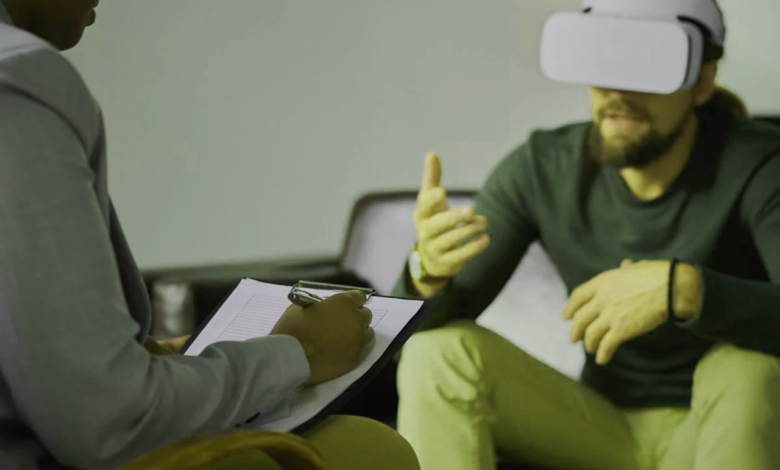Can Virtual Reality Help with Mental Health Treatment?
Virtual reality therapy for mental health offers innovative treatment for anxiety PTSD and phobias through immersive controlled virtual environments.

Virtual reality (VR) is revolutionizing mental health treatment by offering immersive, controlled environments where patients can safely confront and manage psychological challenges. Unlike traditional therapy, VR allows individuals to engage in simulated scenarios tailored to their specific needs. whether it’s overcoming a phobia, practicing social interactions, or processing traumatic memories. This innovative approach enhances exposure therapy, mindfulness training, and cognitive behavioral techniques, making treatment more interactive and effective. As research continues to validate its benefits, VR is emerging as a powerful tool in combating anxiety, PTSD, depression, and other mental health conditions.
The appeal of VR in mental health treatment lies in its ability to bridge the gap between imagination and real-world application. Patients who struggle with conventional talk therapy or find it difficult to visualize scenarios during treatment can benefit from VR’s lifelike simulations. Therapists can adjust the intensity of virtual experiences in real time, ensuring a gradual and personalized healing process. While challenges like cost and accessibility remain, the growing adoption of VR in clinical settings suggests a promising future where technology and therapy work hand-in-hand to improve mental well-being.
Can Virtual Reality Help with Mental Health Treatment?
Virtual Reality in Mental Health Treatment
Virtual reality has opened up new possibilities in psychotherapy by simulating real-world scenarios in a controlled digital environment. This immersive technology allows individuals to engage with situations that may trigger their symptoms while Virtual reality of a therapist. For example, someone with social anxiety can practice public speaking in a virtual auditorium, while a person with PTSD can gradually confront traumatic memories in a safe setting. The ability to adjust the intensity of these experiences makes VR a flexible tool tailored to individual needs. Here’s a detailed breakdown of the advantages of VR exposure therapy (VRET) compared to traditional methods, along with supporting evidence:
Elimination of Real-World Risks
Safe Environment VRET allows patients to confront fears in a controlled, virtual space where no actual danger exists. Reduced Anxiety Unlike real-world exposure (e.g., forcing someone with aerophobia onto a plane), VR provides gradual, therapist-guided simulations. Emergency Control Therapists can immediately pause or adjust scenarios if distress becomes overwhelming.
Logistical Convenience & Accessibility
No Need for Physical Setups Traditional exposure therapy often requires complex arrangements (e.g., finding a tall building for acrophobia treatment). VRET replicates these scenarios instantly in a clinic. Remote Therapy Potential With VR headsets, patients can undergo exposure therapy from home under professional supervision. Cost-Effective Reduces expenses associated with real-world exposure (e.g., travel, hiring specialists like pilots for aviophobia therapy).
Customizable & Repeatable Scenarios
Tailored Intensity Therapists can adjust variables (e.g., height, crowd size, spider size) to match the patient’s progress. Unlimited Repetition Patients can replay scenarios until they feel comfortable, which is impractical in real life (e.g., repeatedly booking flights for flying phobia). Diverse Simulations VR can recreate rare or hard-to-stage situations (e.g., combat zones for PTSD, public speaking for social anxiety Disorder).
Enhanced Engagement & Efficacy
Immersive Realism VR’s 3D visuals and audio increase emotional engagement, making therapy more effective than imagination-based exposure. Biofeedback Integration Some VR systems monitor heart rate or eye tracking to tailor sessions in real time. Faster Desensitization Studies show VRET can accelerate progress compared to traditional methods, with effects lasting years post-treatment.
Evidence-Based Success
Phobias A 2022 JMIR Mental Health review found VRET reduced fear of heights (acrophobia) in 70–80% of patients. PTSD The Journal of Anxiety Disorders reported VRET significantly decreased symptoms in veterans by recreating trauma scenarios safely. Social Anxiety Behaviour Research and Therapy showed VR-based social simulations improved confidence in patients avoiding real interactions.
Overcoming Traditional Therapy Barriers
Patient Resistance Many refuse in vivo exposure due to embarrassment (e.g., crying in public during agoraphobia treatment). VR offers privacy. Therapist Limitations Not all clinics have resources for real-world exposure (e.g., access to airplanes for aviophobia). VR standardizes treatment.
Beyond exposure therapy, VR is also being used for mindfulness and relaxation. Guided meditation programs in virtual reality can transport users to serene landscapes, helping them practice deep breathing and stress reduction techniques. This application is especially useful for individuals with generalized anxiety disorder or chronic stress, as it provides an escape from overwhelming environments. Additionally, Virtual reality-based cognitive behavioral therapy (CBT) is gaining traction, enabling therapists to teach patients how to reframe negative thoughts in an interactive way.
The Role of Virtual Reality
Another promising area is VR’s role in treating PTSD among veterans and trauma survivors. Virtual simulations allow therapists to recreate specific scenarios related to a patient’s trauma, helping them process emotions in a structured manner. Unlike traditional talk therapy, Virtual reality provides a multisensory experience, making it easier for patients to engage with their treatment. Research indicates that VR-assisted therapy can reduce flashbacks and hypervigilance, Virtual reality to recovery for those who have struggled with conventional methods.
Benefits of Virtual Reality
Despite its benefits, VR therapy is not without challenges. High costs and the need for specialized equipment can limit accessibility, particularly in low-income communities. Additionally, some patients may experience motion sickness or discomfort while using VR headsets. There is also a need for more long-term studies to assess Virtual reality durability of VR therapy’s effects. However, as technology becomes more affordable and widespread, these barriers are likely to diminish, making VR an increasingly viable option for mental health treatment.
Read More: The Science Behind Muscle Recovery: What You Need to Know
Conclusion
Virtual reality is transforming mental health treatment by offering immersive, controlled, and customizable therapeutic experiences. From exposure therapy for phobias to PTSD treatment and mindfulness exercises, VR provides innovative solutions that Virtual reality methods. While Virtual reality as cost and accessibility remain, ongoing advancements in technology are paving the way for broader adoption. As research continues to validate its effectiveness, VR could become a standard tool in psychotherapy, helping millions overcome mental health challenges in a safe and engaging manner.
The future of VR in mental health care looks promising, with potential applications extending to remote therapy and AI-driven personalized treatments. As the technology evolves, it may bridge gaps in mental health services, particularly for those who lack access to in-person therapy. While VR is not a replacement for human connection in therapy, it serves as a powerful supplement, enhancing treatment outcomes and offering hope for those seeking alternative healing methods.
FAQs
How does VR help with anxiety disorders?
VR provides controlled exposure to anxiety-inducing situations, allowing patients to practice coping mechanisms in a safe environment before facing real-world challenges.
Is VR therapy effective for PTSD?
Yes, studies show VR-assisted exposure therapy helps trauma survivors process memories in a structured way, reducing symptoms like flashbacks and hypervigilance.
Can VR replace traditional therapy?
No, VR is a supplementary tool that enhances traditional therapy rather than replacing it, offering immersive experiences that support conventional methods.
Are there side effects to VR therapy?
Some users may experience motion sickness or eye strain, but these effects are usually temporary and can be minimized with proper adjustments.
Is VR therapy accessible to everyone?
Currently, cost and equipment requirements limit accessibility, but as technology advances, VR therapy is expected to become more widely available.











